Contractor Stories
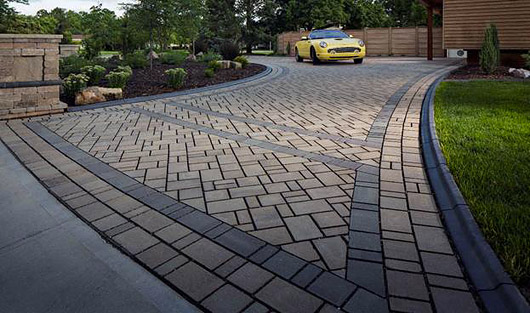
The pavers are laid at a 45 degree angle to the house partly because the road isn’t square to any of the entrances.
The building of a curbed, heated, permeable award winner
Curbing adds class to a heated permeable pavement system that immediately melts and drains snow and ice.
By Tom HatlenIn central Nebraska, you have to be willing to travel a bit for work. Josh Graczyk says, “We’ll do some driving for unique jobs like this. It was an hour away. Right now we’re working 2 hours away.”
This job was exceptional enough to win Grindstone Hardscapes a 2014 HNA Hardscape Project Award in the Residential Permeable Concrete Paver category.
The homeowners, working with a homebuilder friend, had decided they wanted both a permeable paver system and a heated pavement system in the same project even though either system used alone does a job on ice.
With a permeable system, melting snow drains below the pavers rather than remaining on the surface and refreezing into ice. Typically, a plow clears the bulk of the snow, ice melt is applied, and the water goes away.
With the addition of the heated pavement system, no plowing or ice melt is needed. All snow or freezing rain that hits the surface melts and drains immediately.
Josh says, “They’ve been through 2 winters with it and they love it. They say there is no water, no snow. It’s maintenance free and it is absolutely beautiful.”
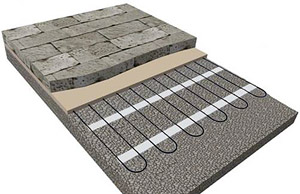
Heating cable is laid out in the bedding layer so that it doesn’t touch the pavers. That’s because potential movement by the pavers over time could wear through the protective coating of the cable and short out the entire installation. This is especially important in a vehicular application like a drive.
A smart heating system
The heating cables in the drive only turn on when there is both precipitation occurring and the temperature is below freezing. So it’s rarely on. Josh says 2 heat/moisture sensors, each about the size of a tennis ball, are installed in the pavement.For those occasions when the sensors do turn the system on, it takes a lot of electricity to heat the 4,300 sf of pavement. Josh says an electrician set a new pedestal in the backyard to add 400 amps to heat the driveway.
A surprise under the old drive
Grindstone Hardscapes began the project by demoing the old concrete driveway and some landscape elements. The plan was to then excavate the drive down 18” to provide a good drainage base. Instead, they excavated 36”, because that’s how deep the base of sand under the old driveway turned out to be.“We went ahead and excavated all that to get to a more solid surface. We filled it with more #2 aggregate, so it’s just got a deeper base on it.
“We had to bill it out hourly to the homeowner and they understood. It was something that we never could have predicted.”
When it was done, there was just under 27” of #2 stone, 4” of #57 and 2” of #9 stone to serve as the paver setting bed.
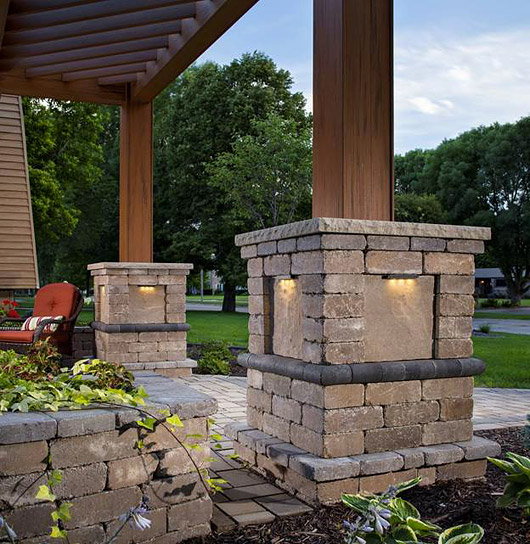
Each column includes 4 LED low voltage lights, and one holds a built in mailbox and package delivery shelf. The columns were designed by a good friend of Grindstone Hardscapes, Justin Hampton of Paver Designs LLC (see article on page 10). Josh says, “Justin actually came down from Omaha for a couple days and helped us build them.”
Project Profile
Merrick Residence, Grand Island, NE2014 HNA Project Award Winner – Residential Concrete Permeable Pavers
Design/build contractor
Grindstone HardscapesJosh & Kristen Graczyk, Owners
Josh Veskerna, Foreman
In-house work
4,300 sf permeable pavers700’ extruded curbing
Low voltage lighting
Steps, columns, planters
Demolition and excavation
Sod, sprinklers, plantings
Underground drainage
Work done by others
PergolaElectrical work for heat system
Year completed
2013You best take care of the cable
The heating cable is installed within the #9 stone layer. To maximize the amount of heat transferred from the heating cable to the pavers, the stone separating the cable and pavers needs as much contact with both as possible. Crushed stone with fines transfers the most heat, but doesn’t drain, so it isn’t used in a permeable installation. Instead, the heating cable manufacturer, Warmzone Radiant, recommends smaller drainage stone (#9) because it has more contact with the cable and transfers more heat than larger stone.So, why not just install the cable at the top so it’s touching the pavers? Bryan Morris at Warmzone says potential movement by the pavers over time could wear through the protective coating of the cable and short out the entire installation.
One misstep of any kind that breaks through the protective coating could mean tearing up the whole job to find an electrical short. So Josh and the crew took great care to safeguard the cable throughout the project.
- They zip-tied the heat cable to wire mesh (typically used to reinforce concrete) to ensure the cable stayed down flat and didn’t pup up out of the bedding layer and rub against the pavers.
- With the cable in place, they affixed wooden bumpers they had created to the front of their wheelbarrows before installing the bedding stone. Josh says, “We made darn sure that we didn’t pierce any of that wire.”
Before the heating cable and bedding layer went in, 9 columns and 2 raised beds were built. Next came the heating cable, bedding layer, pavers and edge restraint. Decorative curbing was then extruded over the edge restraint. Planting and mulching followed.
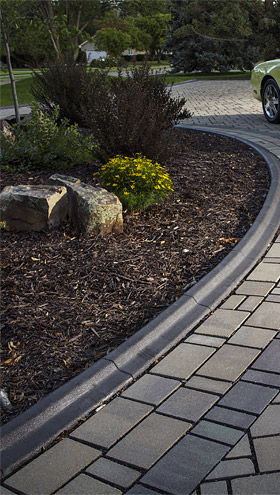
The decorative concrete curbing sits on top of the edge restraint adding a classy finish to the pavement and extra stability to the edge restraint. Matching curbing also lines the landscape beds throughout the property. The curbing maintains the solid charcoal color to the core so it won’t scratch off. Josh runs a separate full-time curbing business, Curb-it, Inc., though his hardscape crew installed this one.
For permeable installations, they normally add a grid underneath the pavers that ties into the edge restraint holding it tight against the pavers. But Josh says, “We didn’t use grid here because it was a real mess trying to do that with all the curves everywhere.”
Since they weren’t using grid and since edging spikes don’t hold well in drainage rock, they installed a traditional paver base for the outside 18” and secured spikes into that.
Sweet home Nebraska
With the project completed, the homeowners celebrated by throwing a party for the crew. Josh says people like these homeowners are another reason he doesn’t mind traveling for work.“The people we work for in Central Nebraska are so good to us. Every time, we just seem to connect and develop a relationship that lasts. On this project, every single day at about 3pm the homeowner had watermelon and pop or water or ice cream out for us. She would have muffins and rolls and donuts waiting for us when we got there in the morning. I feel we're fortunate to live where we do. I don’t think you see this everywhere.”
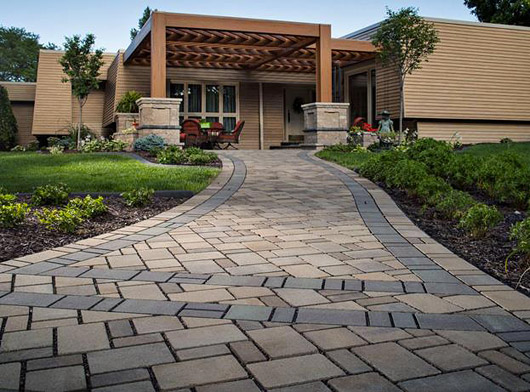
The walkway to the front door is heated just like the drive. The homebuilder/general contractor built the pergola after Grindstone Hardscapes installed the footings and columns with steel sleeves for the posts. The cross beams in the pergola roof reflect the angle of the pavers.















